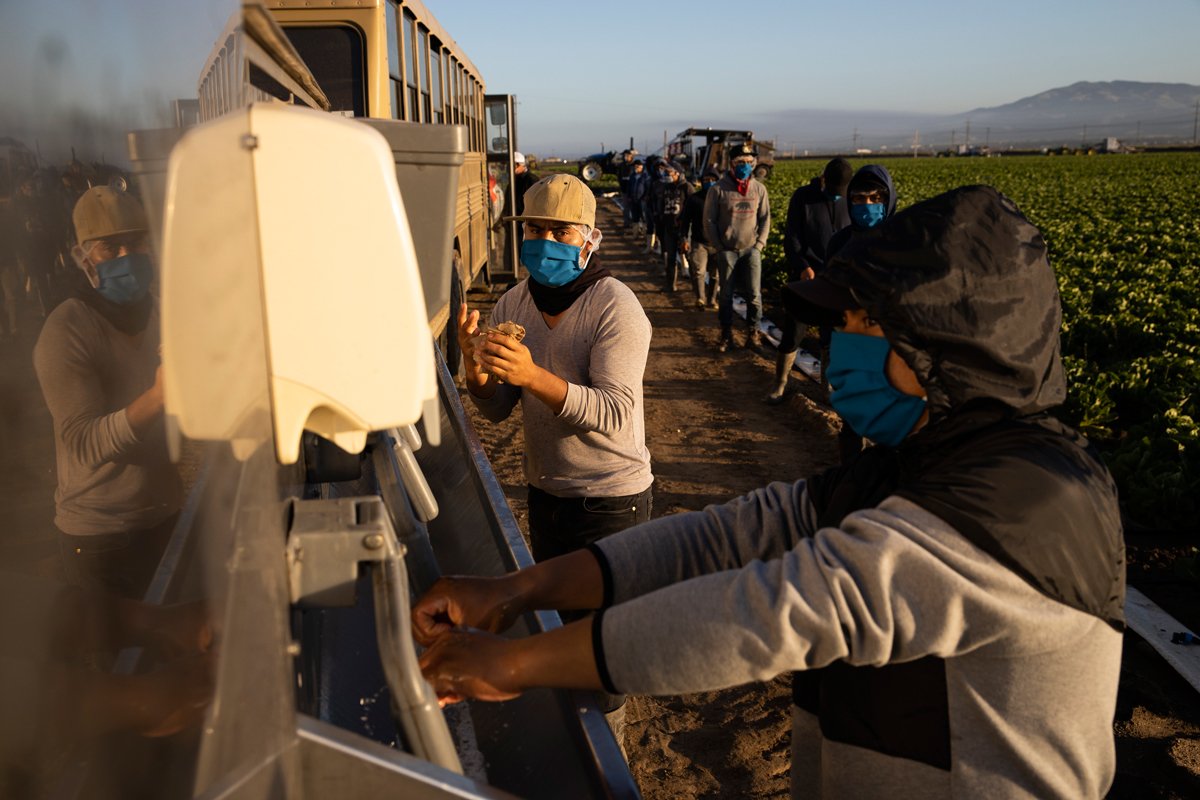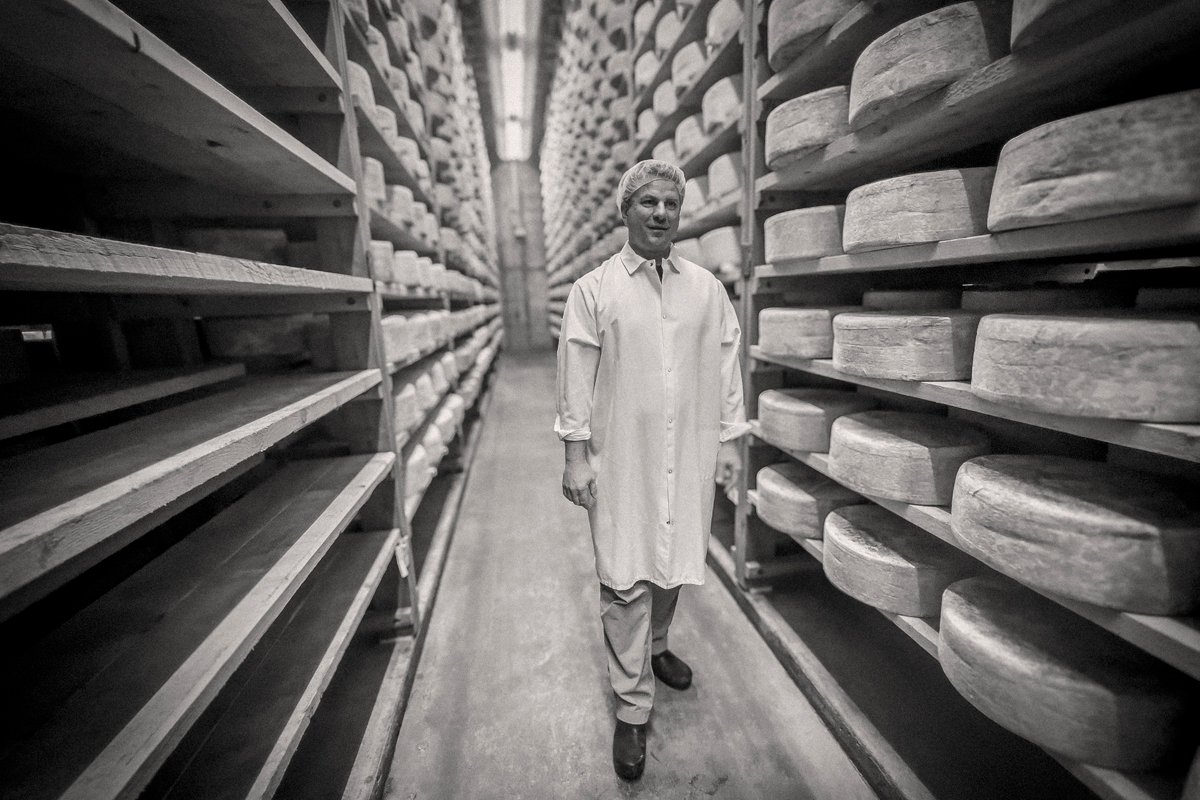Workers on H2-A visas are being hard hit by COVID-19 because they work in large groups, know little about their rights in the U.S., and live in remote camps and other communal housing cut off from outside resources.

Workers on H2-A visas are being hard hit by COVID-19 because they work in large groups, know little about their rights in the U.S., and live in remote camps and other communal housing cut off from outside resources.
August 27, 2020

The two farmworkers had nearly identical stories. They shared the same first name, Juan Carlos. They both hailed from the municipality of Tolimán in the Mexican state of Querétaro. And they had both been traveling as guest workers for Gebbers Farms every summer to pick cherries in Washington state, where H-2A workers are an increasing part of the agricultural labor force.
The two shared the same cabin at the labor camp near Brewster, Washington. They harvested cherries off the same trees, a team of two. And they both got sick with COVID-19.
On a hot July day, both men rested in their cabin, too sick to work. They had both been ravaged by fever, cough, body aches, and diarrhea, with no appetite or sense of smell, and a Gebbers employee stopped by to inquire about sick workers.
Juan Carlos Santiago Fuentes swore he felt fine and wanted to remain in the cabin.
Juan Carlos Santiago Rincon agreed to go to the company’s isolation camp. He died later that night, without getting medical help.
Within a few weeks, two other Gebbers employees had died from the virus; Jamaican guest worker Earl Edwards, who had also been placed in an isolation camp, and the Mexican-American supervisor Francisco Montiel, who drove Santiago Rincon and his colleagues to and from the fields. More than 120 workers had tested positive for COVID-19 and an additional 150 were displaying symptoms.
The company said it did everything it could to prevent the virus from spreading and help those infected. But workers and state investigators had a different view. Santiago Fuentes said Gebbers failed at preventive measures and didn’t provide access to testing or a doctor. Eleven days after his friend died, he returned home early to Querétaro. He was part of a wave of Gebbers guest workers who quit mid-harvest, leaving behind half-empty labor camps and unpicked fruit.
“I decided to go back for my own sake, for my life, for my family,” Santiago Fuentes told Civil Eats by phone from Mexico. “I was afraid the same thing would happen to me . . . that I would return as my companion, in ashes.” Of the seven people in his cabin, five got sick with the virus and at the time of the call, only two remained in Washington to continue with the harvest, he added.
“I decided to go back for my own sake, for my life, for my family. I was afraid the same thing would happen to me that I would return as my companion, in ashes.”
Earlier this month, Washington state Governor Jay Inslee ordered Gebbers Farms to test all of its employees. He also issued a broad new mandate that requires agricultural businesses to test all employees if more than nine workers or 10 percent of the workforce come down with the virus in 14 days. The sweeping mandate also requires that guest workers sent to isolation camps must be checked by health professionals twice daily.
The Gebbers Farms outbreak is one of the largest so far, but it’s also one of many that have been taking place across the country among agricultural H2-A workers. Advocates say the workers, most of whom come on temporary visas from Mexico, are especially vulnerable to the virus because they work and are housed in large groups, know little about their rights in the U.S., and live in remote camps and other communal housing that’s cut off from outside resources.
“Guest workers are not out in the community. They don’t know anyone, so they’re not able to advocate for themselves,” said Maricela Morales, executive director of the California’s Central Coast Alliance United for a Sustainable Economy (CAUSE). “And compliance with virus prevention measures and the response to outbreaks is completely inconsistent among agricultural employers and labor contractors.”
Confined Housing, Fear of Speaking Out Fuel Outbreak
Since the start of the pandemic, worker advocates have warned that the arrival of a large number of guest workers during harvest season would lead to a surge in infections. Now, that prediction has become a reality, as COVID-19 cases have exploded in agricultural regions.
The H-2A program—which brings in workers from outside the U.S. legally due to a shortage of people in the U.S. willing to work for the wages farms provide—has swelled by nearly 200 percent over the past decade. And while the Trump administration has curtailed other temporary visa programs during the pandemic, it encouraged farms to continue bringing in guest workers. During the first three quarters of 2020, nearly 225,000 workers were certified to come to the U.S.—meaning this year’s total would likely well exceed 2019’s count.
Most of these workers are concentrated in five states—Florida, Washington, Georgia, California, and North Carolina—where they harvest berries, cherries, apples, row crops, tobacco, and lettuce.
While H-2A visas are highly coveted outside the U.S., advocates here say the program is rife with abuses. The very nature of the H-2A work agreements often keep guest workers from speaking out about problems, including the virus, lest they be seen as trouble makers. That’s because their visas and legal status, work, transportation, food, and housing are all tied to a single agricultural employer, said Armando Elenes, secretary treasurer of the United Farm Workers (UFW).
“A lot of H-2A workers are not coming forward when they’re sick because of the huge fear that they might lose their jobs, their pay, their visas, and that they might not be called back next season,” said Elenes.
Housing and transportation are other points of concern. Guest workers typically share cabins with bunk beds in a labor camp or cramped hotel rooms, and sometimes trailer homes or apartments. On average, five to seven workers share a small cabin or room; bathroom and kitchen/dining facilities are also shared among larger groups, and men from multiple rooms or cabins are transported together to the fields and grouped into crews to work, facilitating COVID-19 transmission.

In many cases, advocates say, public health officials don’t know the locations of guest worker housing and the agricultural companies don’t notify them about the outbreaks until it’s too late for them to protect themselves.
And federal, state, and local governments have done little to address guest workers’ risks of infection from COVID-19. In Washington state, farmworker unions filed suit in April to push for mandatory, stringent, and enforceable rules to protect farmworkers—with a special focus on housing for H-2A workers.
Within a few weeks, the state’s Department of Labor & Industries issued an emergency rule regarding temporary farmworker housing, specifying that bunk beds were allowed only if the guest workers were grouped together in groups of no more than 15 people. The rules also require employers to provide face coverings to workers, and make provisions for social distancing, frequently clean and sanitize housing surfaces, and detect and isolate workers suspected of having COVID-19.
But farmworker advocates say the policy has fallen short. Familias Unidas por la Justicia, an independent farmworker union based in the Skagit Valley, sued over the emergency rule, arguing that the state should have outright banned bunk beds. Oregon instituted such a ban earlier this summer. But farm groups argued Oregon has fewer guest workers and banning bunk beds in Washington state would have cut the available housing in half. Then, last month, a judge upheld the state’s emergency housing provisions.
Two Masks, a Small Bottle of Sanitizer, and No Tests or Doctors
Gebbers Farms, it turns out, did not adhere to the state’s emergency rule because it separated its workers into larger groups. Every year, the company employs about 4,500 farmworkers, including 2,500 guest workers from Mexico, Jamaica, and other parts of the world. Work during cherry harvest, which starts in June, is exhausting even for healthy young men. They rise before dawn and put in 8-10 hour days in the scorching heat, with no days off for weeks, said Santiago Fuentes.
Initially, workers were taken to the orchards by bus, 44 per vehicle, Santiago Fuentes said. More recently, Gebbers divided them into smaller groups of 22. Personal protective equipment was sparse, he said. Workers received only two masks on arrival, one disposable and one reusable, and one small bottle of hand sanitizer. And the company did not disinfect the cabins, the cherry ladders, or the buckets between uses.
Most crucially, Santiago Fuentes said, the company didn’t provide access to testing or to medical care, even to workers in the isolation camps. Some drove themselves to a local clinic to get tested and treated, but the cost—which the company did not cover—was a deterrent. One worker, who rushed to a clinic because he couldn’t breathe, was stuck with a $3,000 bill, said Santiago Fuentes. As a result, many kept silent and continued to harvest cherries despite persistent coughs and fevers.
“It’s heartbreaking, they were out in these remote areas and they didn’t have access to emergency services.”
Victoria Ruddy, the Pacific Northwest regional director for the UFW, visited several Gebbers labor camps and two isolation camps this month, and she confirmed that no medical help was available. Workers told Ruddy most had not seen a health care professional and had not been tested for the virus whilst in isolation, she said.
“It’s heartbreaking, they were out in these remote areas and they didn’t have access to emergency services,” Ruddy said.
None of the camps she visited had WiFi and several had no cell phone signal. In an emergency, workers had to find someone to drive them to the emergency room or to an area with cell reception so that they could call 911, she said.
Company Said it Followed Rules, State Investigators Disagree
In a recent email exchange, company spokesperson Amy Philpott wrote that Gebbers has always followed strict safety protocols.
Philpott also said guest workers who display symptoms are quarantined in designated housing. “Someone checks on guest workers regularly, conducts interviews using a standard questionnaire about symptoms, and asks employees daily if they’d like to see a doctor,” she wrote, adding that workers in quarantine are provided with both thermometers and finger oxygen meters.
When it comes to testing, Philpott said, the company did not provide COVID-19 tests because they were initially difficult to obtain and too costly. But, she added, Gebbers encouraged employees to get tested and provided free transportation to and from the test sites.
The farm also encouraged local public health officials and a local clinic to visit the workers in the isolation camps, said Dan Fazio, executive director of Wafla, the organization that helped Gebbers hire its foreign laborers. However, Wafla recently found out that those visits did not happen, Fazio admitted, although he added that it was not “Gebbers’ responsibility to drive these workers to a doctor on a daily basis.” Wafla has since made a $25,000 donation to Okanogan County Public Health, he said, so that the county would conduct the daily wellness checks.
After the farmworker union reported Santiago Rincon’s death to the state, the Department of Labor & Industries launched an investigation. The state issued an “Order and Notice of Immediate Restraint,” which requires Gebbers to either remove bunk beds at all of its labor camps or comply with the emergency rule that requiring groups no larger than 15.
Tim Church, a spokesman with Labor & Industries, said investigators have visited multiple Gebbers camps last month, and now “they appear to be following the order.” Philpott, the Gebbers spokeswoman, confirmed the size of worker groups is now 14 people to meet the state’s requirement.
“The farm is working closely with the state to identify and implement any necessary changes to its protocols,” Philpott said.
As cases have exploded in Okanogan County, home to the labor camp near Brewster, the local public health department is offering free COVID-19 testing this month to all of its residents, including the guest workers. Governor Inslee’s order also requires agricultural employers to provide an emergency phone for workers in isolation.
Independent Inspections Instead of Dependence on Farmers’ Goodwill
In California, where the use of guest workers has grown rapidly in recent years, guest worker housing also has fueled several COVID-19 outbreaks, according to CAUSE’s Morales.
In July, about 200 workers tested positive for COVID-19 in Oxnard at Villa Las Brisas, a recently renovated labor camp owned by Reiter Affiliated Companies, one of the world’s largest fresh berry producers. The company leases the dorm-style accommodations to three labor contractors.
On its Facebook page, Reiter wrote that it had reviewed the camp’s safety and hygiene protocols with Ventura County Public Health in April and was found to be in compliance. The outbreak was reported to the county, which is guiding the workers’ quarantine and medical care and all workers are in stable condition with mild symptoms, the company said.
That same month, at least 85 guest workers at three motels in the agricultural town of Santa Maria tested positive for COVID-19. They had arrived in the spring for the lettuce harvest and were employed by farm labor contractor Alco Harvesting. One man, Leodegario Chavez Alvarado, a crew supervisor who lived with the workers and drove them to and from the fields, died in the outbreak, Morales said.
Just like at Gebbers Farms, the guest workers in the Santa Maria motels told CAUSE that they were practically cut off from the world. The company brought them food, but provided no medical attention. Like in Washington, some workers broke their contracts and returned home early.
And evidence suggests that Alco wasn’t forthcoming about the outbreak either. Local health officials found out after a worker called the state to complain about wage theft and mentioned that one of his co-workers had just died. The state then launched an investigation and notified Santa Barbara County Public Health.
“We’re up against this nostalgic myth of the family farmers. If they say they’re complying, we believe them. But in the midst of the pandemic, we can’t just say we trust in the goodness of the growers.”
CAUSE has for months advocated for more protections for guest workers. The problem, said Morales, is that there was no oversight or enforcement health and safety laws before the pandemic, and the situation hasn’t improved.
“Even when laws and recommendations are agreed to, without oversight, they become almost meaningless,” Morales said. “We’re up against this nostalgic myth of the family farmers . . . If they say they’re complying, we believe them. But in the midst of the pandemic, we can’t just say we trust in the goodness of the growers.”
In recent months, CAUSE has pushed for independent, unplanned inspections in the fields. While farms are private property, public health officials could easily do visual inspections from the side of the road, Morales said.
“Why do we have to wait until an outbreak has happened or until a worker has died?” she said.
Another key recommendation from Clinicas del Camino Real, Inc., the clinic system that serves farmworkers in Ventura County, is to address the severe overcrowding in farmworker housing during the pandemic.
California’s Governor Gavin Newsom announced late last month that he would create temporary farmworker housing at hotels and motels to quarantine workers who have either tested positive or have been exposed to someone with COVID-19. The California Department of Food and Agriculture said the housing will be available to any individual working in the agricultural sector (including guest workers). Local administrators can sign workers up and provide transportation, meal delivery, and wellness checks. The program, said Steve Lyle with CDFA, will launch with the initial counties in the coming days.
But Morales said temporary quarantine housing does not prevent the virus from spreading in the first place. What’s needed is more permanent housing for farmworkers.
“We have an opportunity to give greater visibility to the farmworkers who have been invisible,” said Morales. “They’re still being taken for granted and we need to keep pressing on our public health and elected officials to do right by them.”
Established Relationships Help Contain Outbreak at Labor Camp
Given the dearth of regulations, it’s vital that local clinics and advocacy nonprofits establish good working relationships with the employers who run labor camps, said Jessica Rodriguez, outreach coordinator for the Vecinos Farmworker Health Program based in North Carolina.
North Carolina farmers have brought in about 21,000 H-2A workers into the state the last year, and it has seen COVID-19 cases soar among this group. In Sparta, in the northern part of the state, 112 of the 400 guest workers tested positive for the virus at Bottomley Evergreens & Farms, which grows Christmas trees. And Vecinos is currently helping to address outbreaks at two guest worker labor camps at Norton Creek Farms in the western part of the state. More than half of one farm’s 80 guest workers who arrived for blackberry harvest have tested positive for the virus.
“Why do we have to wait until an outbreak has happened or until a worker has died?”
Vecinos has offered free health care for farmworkers since 2001. The staff there regularly locate H-2A labor camps through a U.S. Department of Labor database and establish relationships with the owners, foremen, and workers. At the beginning of the pandemic, the group conducted educational sessions about social distancing and other measures, handed out PPE, and worked closely with the foreman to update him on new federal and state policies related to virus prevention.
Norton Creek Farms took a variety of safety measures. But because the workers didn’t have individual quarters, bathrooms, or kitchens, it was virtually impossible to prevent the virus from spreading, said Rodriguez. Another challenge is that local labs are often backed up, with some taking up to 10 days to give test results, by which time it’s too late.
“We assume if one guest worker gets sick, all of them are getting sick,” Rodriguez said.
Vecinos stepped in quickly to help with the recent outbreak. The farm coordinated food for the workers. And Vecinos did daily medical checks and medication drops. All of the workers were tested and will be retested, she said. The farm will also require workers to wear masks while in the fields.
“We’re using this outbreak as a model for other camps,” said Rodriguez. “The pandemic is not ending anytime soon, so we need to continue taking precautions and working together.”
Returning to Work in the U.S.
Meanwhile, Santiago Fuentes and his colleagues hope to return to work next year, though for a different company. And they’re afraid that H-2A recruiters in Mexico or U.S. farm employers might blacklist them.
“These are the only good jobs one can find to get financial relief. Here in Mexico, the situation is very ugly,” Santiago Fuentes said. “But I’m glad I made the decision I made. My life is worth more than the money.”
For now, he’s taken a job in the Mexican fields weeding tomatoes. He earns 130 Mexican pesos, or the equivalent of less than $6, per day.

September 4, 2024
By paying top dollar for milk and sourcing within 15 miles of its creamery, Jasper Hill supports an entire community.
September 3, 2024

August 27, 2024

August 26, 2024

Like the story?
Join the conversation.